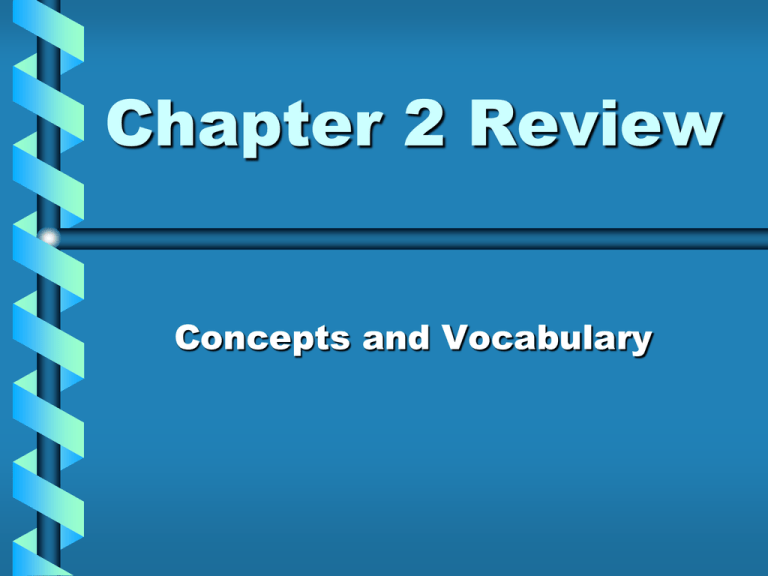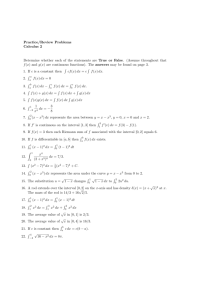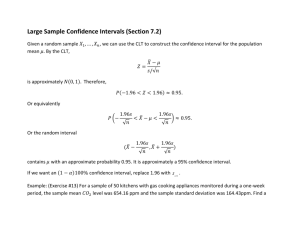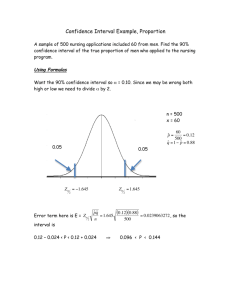Ch 2 Review
advertisement

Chapter 2 Review Concepts and Vocabulary Q1. If a function is defined by the equation y = f(x), then x is called the _?_ variable and y is the _?_ variable. A1. independent dependent Q2. A set of points in the xyplane is the graph of a function if and only if every _?_ line intersects the graph in at most one point. A2. vertical Q3. The set of all images of the elements in the domain of a function is called the _?_. A3. range Q4. True or False: Every relation is a function. A4. False Q5. True or False: The y-intercept of the graph of the function y = f(x), whose domain is all real numbers, is f(0). A5. True Q6. True or False: The independent variable is sometimes referred to as the argument of the function. A6. True Q7. For the graph of the linear function f(x) = mx + b, m is the _?_ and b is the _?_. A7. slope y-intercept Q8. True or False: The correlation coefficient is a measure of the strength of a linear relation between two variables and must lie between -1 and 1, inclusive. A8. True Q9. The average rate of change of a function equals the _?_ of the secant line. A9. slope Q10. A function f is _?_ on an open interval if for any choice of x1 and x2 in the interval, with x1<x2, we have f(x1) < f(x2). A10. increasing Q11. An _?_ function f is one for which f(-x) = f(x) for every x in the domain of f. A11. even Q12. An _?_ function f is one for which f(-x) = -f(x) for every x in the domain of f. A12. odd Q13. True or False: Even functions have graphs that are symmetric with respect to the origin. A13. false Q14. The graph of f(x) = mx + b is decreasing if m is _?_ than zero. A14. less Q15. When functions are defined by more than one equation, they are called _?_ functions. A15. piecewise Q16. True or False: The cube function is odd and is increasing on the interval (- ∞, ∞). A16. true Q17. True or False: The domain and range of the reciprocal function are the set of all real numbers. A17. false Q18. Given f(x), then the graph of y = f(x – 2) may be obtained by a(n) _?_ shift of the graph of f a distance of 2 units to the _?_. A18. horizontal right Q19. Given f(x), then the graph of y = f(-x) may be obtained by a reflection about the _?_-axis of the graph of the function y = f(x). A19. y Q20. Given f(x), then the graph of y = 3f(x) may be obtained by a vertical _?_ of the graph of f by a factor of _?_. A20. stretch 3 Q21. True or False: The graph of y = - f(x) is the reflection about the x-axis of the graph of y = f(x). A21. true Q22. True or False: To obtain the graph of y = f(x+2) – 3, shift the graph of y = f(x) horizontally to the right 2 units and vertically down 3 units. A22. false Q23. True or False: To obtain the graph of y = f(4x), horizontally compress the graph of y = f(x) by a factor of 4 . That is, divide each xcoordinate on the graph of y = f(x) by 4. A23. true Q24. If the domain of f is all real numbers in the interval [0,7], and the domain of g is all real numbers in the interval [-2,5], then the domain of f + g is all real numbers in the interval _?_. A24. [0,5] Q25. The domain of f/g consists of all real numbers x for which g(x) _?_ 0 that are in the domains of both _?_ and _?_. A25. ≠ f g Q26. If f(x) = x + 1 and g(x) = x³, then _?_ = (x + 1)³ . A26. g(f(x)) Q27. True or False: f(g(x)) = f(x)· g(x) A27. false Q28. True or False: The domain of (f· g)(x) consists of the numbers x that are in the domains of both f and g. A28. true Q29. True or False: The domain of the composite function (f ◦ g)(x) is the same as the domain of g(x). A29. false Q30. What is the best way to study for a Math test? A30. Work problems!











